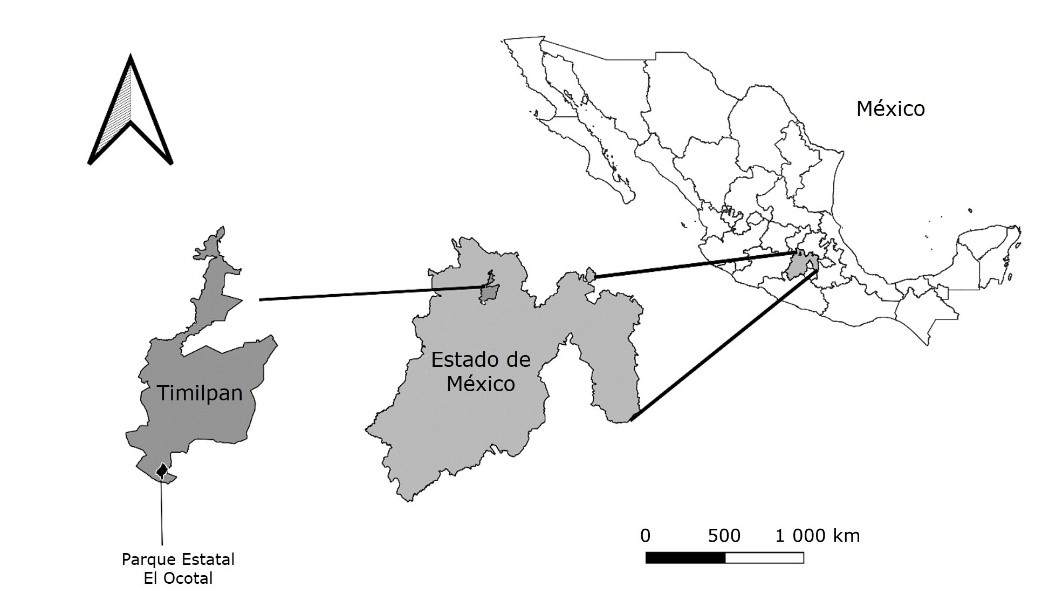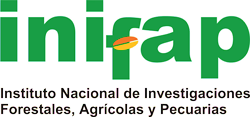Land uses, soil properties and carbon storage in El Ocotal State Park, Mexico
DOI:
https://doi.org/10.29298/rmcf.v16i88.1512Keywords:
Carbon stores, conservation, nutrients, tree biomass, regulatory ecosystem services, soil propertiesAbstract
The El Ocotal State Park, located in Estado de México, is a priority area for the protection and conservation of local ecosystems, playing a prominent role in the provision of ecosystem services. In addition to being a source of employment through ecotourism, this area faces challenges stemming from historical land-use changes, which have caused significant transformations in the structure and composition of its soil and vegetation cover. However, the extent of these alterations and their implications for the ecosystem services provided by the park remain poorly understood. In this context, the present study focused on estimating the capacity of the park's soil and tree vegetation to preserve and enhance ecosystem services related to carbon capture and storage. Through the analysis of the physical and chemical properties of the soil, mensuration records of the trees, and allometric equations, the capacity of forest communities to store carbon in soils and tree biomass was determined. The largest carbon reservoirs were found in tree biomass, with values ranging from 123 to 330 Mg ha-1, while soils registered between 51 and 128 Mg ha-1. Reforestation with 20-year-old Pinus pseudostrobus showed the highest Total Organic Carbon storage capacity, with 406 Mg ha-1. These results underscore the importance of conserving and regulating the use of the park’s natural resources to ensure the continuous provision of its ecosystem services.
Downloads
References
Afanador-Barajas, L. N., Coca P., D. A., Vargas G., A. F., Bautista M., M. F., Mendoza H., A., y Vallejo Q., V. E. (2020). Evaluación de la calidad de suelos en agroecosistemas de Colombia a través de la selección de un conjunto mínimo de datos. Colombia Forestal, 23(1), 35-50. https://doi.org/10.14483/2256201X.14856
Aguirre-Calderón, O. A., y Jiménez-Pérez, J. (2011). Evaluación del contenido de carbono en bosques del Sur de Nuevo León. Revista Mexicana de Ciencias Forestales, 2(6), 73-84. https://doi.org/10.29298/rmcf.v2i6.575
Álvarez-Arteaga, G., Ibáñez-Huerta, A., Orozco-Hernández, M. E., y García-Fajardo, B. (2020). Regionalización de indicadores de calidad para suelos degradados por actividades agrícolas y pecuarias en el altiplano central de México. Quivera, Revista de Estudios Territoriales, 22(2), 5-19. https://doi.org/10.36677/qret.v22i2.13302
Andrés-Abellán, M., Wic-Baena, C., López-Serrano, F. R., García-Morote, F. A., Martínez-García, E., Picazo, M. I., Rubio, E., Moreno-Ortego, J. L., Bastida-López, F., & García-Izquierdo, C. (2019).A soil-quality index for soil from Mediterranean forests. European Journal of Soil Science, 70(5), 1001-1011. https://doi.org/10.1111/ejss.12798
Arriola P., V. J., Estrada M., E., Ortega-Rubio, A., Pérez M., R., y Gijón H., A. R. (2014). Deterioro en áreas naturales protegidas del centro de México y del Eje Neovolcánico Transversal. Investigación y Ciencia, 60, 37-49. https://www.redalyc.org/pdf/674/67431160005.pdf
Bolaños G., Y., Bolaños G., M. A., Paz P., F., y Ponce P., J. I. (2017). Estimación de carbono almacenado en bosques de oyamel y ciprés en Texcoco, Estado de México. Terra Latinoamericana, 35(1), 73-86. https://doi.org/10.28940/terra.v35i1.243
Canedoli, C., Ferrè, C., El Khair, D. A., Comolli, R., Liga, C., Mazzucchelli, F., Proietto, A., Rota, N., Colombo, G., Bassano, B., Viterbi, R., & Padoa-Schioppa, E. (2020). Evaluation of ecosystem services in a protected mountain area: Soil organic carbon stock and biodiversity in alpine forests and grasslands. Ecosystem Services, 44, Article 101135. https://doi.org/10.1016/j.ecoser.2020.101135
Cano-Flores, O., Vela-Correa, G., Acevedo-Sandoval, O. A., y Valera-Pérez, M. Á. (2020). Concentraciones de carbono orgánico en el arbolado y suelos del área natural protegida El Faro en Tlalmanalco, Estado de México. Terra Latinoamericana, 38(4), 895-905. https://doi.org/10.28940/terra.v38i4.757
Canteiro, M., Córdova-Tapia, F., & Brazeiro, A. (2018). Tourism impact assessment: A tool to evaluate the environmental impacts of touristic activities in Natural Protected Areas. Tourism Management Perspectives, 28, 220-227. https://doi.org/10.1016/j.tmp.2018.09.007
Chavarría O., Y., Martínez G., A. L., Ortíz C., E., y Goyenechea, I. (2019). Evolución en la selección de áreas protegidas en el continente americano: el caso de Estados Unidos, México y Costa Rica. Boletín Científico del Instituto de Ciencias Básicas e Ingenierías, 7(13), 47-53. https://doi.org/10.29057/icbi.v7i13.3433
Chertov, O. G., & Nadporozhskaya, M. A. (2018). Humus forms in forest soils: Concepts and classifications. Eurasian Soil Science, 51, 1142-1153. https://doi.org/10.1134/S1064229318100022
Cruz-Flores, G., y Etchevers-Barra, J. D. (2011). Contenidos de carbono orgánico de suelos someros en pinares y abetales de áreas protegidas de México. Agrociencia, 45(8), 849-862. https://www.scielo.org.mx/pdf/agro/v45n8/v45n8a1.pdf
Etchevers B., J. D., Monreal, C. M., Hidalgo M., C., Acosta M., M., y Padilla C., J. (2005). Manual para la determinación de carbono en la parte aérea y subterránea de sistemas de producción en laderas. Colegio de Posgraduados. https://catalogosiidca.csuca.org/Record/UCR.000624421/Details
Geographic Resources Analysis Support System. (2022). GRASSGIS, Bringing advanced geospatial technologies to the world (Version 3.22) [Software]. Open Source Geospatial Foundation. https://grass.osgeo.org/
Gillerot, L., Grussu, G., Condor-Golec, R., Tavani, R., Dargush, P., & Attorre, F. (2021). Progress on incorporating biodiversity monitoring in REDD+ through national forest inventories. Global Ecology and Conservation, 3K2, Article e01901. https://doi.org/10.1016/j.gecco.2021.e01901
Gobierno del Estado de México. (1999). Programa de Manejo del Parque Natural de Recreación Popular El Ocotal. Secretaría de Ecología, Comisión Estatal de Parques Naturales y de la Fauna y Universidad Autónoma del Estado de México-Facultad de Geografía.
Instituto Nacional de Estadística y Geografía. (2016). Anuario estadístico y geográfico por entidad federativa 2016. INEGI. http://internet.contenidos.inegi.org.mx/contenidos/Productos/prod_serv/contenidos/espanol/bvinegi/productos/nueva_estruc/AEGPEF_2016/702825087357.pdf
Leyva-Pablo, T., de León-González, F., Etchevers-Barra, J. D., Cortés-Pérez, M., Santiago-García, W., Ponce M., A. y Fuentes-Ponce, M. H. (2021). Almacenamiento de carbono en bosques con manejo forestal comunitario. Madera y Bosques, 27(4), e2742421. https://doi.org/10.21829/myb.2021.2742421
Medina-Castro, Y. E., Roldán-Clarà, B., y Leyva A., J. C. (2019). Impactos del turismo en dos Parques Nacionales y áreas aledañas de Baja California, México: el caso de Sierra de San Pedro Mártir y Constitución de 1857. Sociedad y Ambiente, 7(19), 165-194. https://revistas.ecosur.mx/sociedadyambiente/index.php/sya/article/view/1940
NOM-021-RECNAT-2000. (2001, 14 de agosto). NORMA Oficial Mexicana NOM-021-RECNAT-2000, Que establece las especificaciones de fertilidad, salinidad y clasificación de suelo. Estudios, muestreo y análisis. Diario Oficial de la Federación, Segunda Sección, de 31 de diciembre de 2002. https://www.ordenjuridico.gob.mx/Documentos/Federal/wo69255.pdf
Pérez L., P., López B., F., García O., F., Cuevas-Reyes, P., y González-Rodríguez, A. (2013). Procesos de regeneración natural en bosques de encinos: factores facilitadores y limitantes. Biológicas, 1, 18-24. https://www.biologicas.umich.mx/index.php?journal=biologicas&page=article&op=view&path%5B%5D=148&path%5B%5D=pdf
Pérez R., C., Zizumbo, L., y González V., M. (2009). Impacto ambiental del turismo en áreas naturales protegidas; procedimiento metodológico para el análisis en el Parque Estatal El Ocotal, México. El Periplo Sustentable, (16), 25-56. https://rperiplo.uaemex.mx/article/view/5038/3628
Rodríguez B., P. C., González R., H., Cantú S., I., Pando M., M., Marmolejo M., J. G., Gómez M., M. V., y Lazcano C., J. (2019). Modelos de degradación de la hojarasca en bosques de encino y de pino en Nuevo León. Revista Mexicana de Ciencias Forestales, 10(55), 39-55. https://doi.org/10.29298/rmcf.v10i55.548
Ronquillo-Gorgúa, N., Razo-Zárate, R., Rodríguez-Laguna, R., Acevedo-Sandoval, O. A., Hernández-Ortiz, J., & Manzur-Chávez, N. (2022). Carbon storage during the development stages of Pinus patula Schiede ex Schltdl. & Cham. in the Sierra Alta of Hidalgo. Revista Chapingo Serie Ciencias Forestales y del Ambiente, 28(3), 483-497. https://doi.org/10.5154/r.rchscfa.2022.02.009
Rosaliano E., R., Ávila-Akerberg, V., Franco-Maass, S., Valencia A., S., y López M., L. A. (2022). Estructura y diversidad arbórea en bosques de encino del centro de México. Madera y Bosques, 28(2), Artículo e2822449. https://doi.org/10.21829/myb.2022.2822449
Siebe, C., Jahn, R., y Stahr, K. (2016). Manual para la descripción y evaluación ecológica de suelos en el campo (3ra Ed.). Instituto de Geología de la Universidad Nacional Autónoma de México. https://es.scribd.com/document/686053151/Manual3Siebe-1
Statistical Package for the Social Sciences Inc. (2009). PASW Statistics for Windows (Version 18.0.) [Software]. SPSS Inc. https://www.ibm.com/support/pages/how-cite-ibm-spss-statistics-or-earlier-versions-spss
Torres R., J. M. (2021). Factores ambientales y físicos que afectan la supervivencia de siete especies forestales en el Estado de México. Revista Mexicana de Ciencias Forestales, 12(64), 66-91. https://doi.org/10.29298/rmcf.v12i64.831
van Reeuwijk, L. P. (Comp.). (2002). Procedures for soil analysis. International Soil Reference and Information Centre. https://www.isric.org/sites/default/files/ISRIC_TechPap09.pdf
Vargas-Larreta, B., Amezcua R., M., López-Martínez, J. O., Cueto-Wong, J. A., Cruz-Cobos, F., Nájera-Luna, J. A., & Aguirre-Calderón, C. G. (2023). Estimating soil organic carbon stocks in three temperate forest types in Durango, México. Botanical Sciences, 101(1), 90-101. https://doi.org/10.17129/botsci.3094
Wang, L., Guo, J., Liu, X., Li, K., Ma, L., Tian, Y., Wang, J., Zhang, Q., Tian, Y., Li, C., & Lu, M. (2023). Assessment of soil quality in an arid and barren mountainous of Shandong province, China. Scientific Reports, 13, Article 19966. https://doi.org/10.1038/s41598-023-46136-6

Published
How to Cite
Issue
Section
License
Copyright (c) 2025 Revista Mexicana de Ciencias Forestales

This work is licensed under a Creative Commons Attribution-NonCommercial 4.0 International License.
The authors who publish in Revista Mexicana de Ciencias Forestales accept the following conditions:
In accordance with copyright laws, Revista Mexicana de Ciencias Forestales recognizes and respects the authors’ moral right and ownership of property rights which will be transferred to the journal for dissemination in open access.
All the texts published by Revista Mexicana de Ciencias Forestales –with no exception– are distributed under a Creative Commons License Attribution-NonCommercial 4.0 International (CC BY-NC 4.0), which allows third parties to use the publication as long as the work’s authorship and its first publication in this journal are mentioned
The author(s) can enter into independent and additional contractual agreements for the nonexclusive distribution of the version of the article published in Revista Mexicana de Ciencias Forestales (for example, include it into an institutional repository or publish it in a book) as long as it is clearly and explicitly indicated that the work was published for the first time in Revista Mexicana de Ciencias Forestales.
For all the above, the authors shall send the form of Letter-transfer of Property Rights for the first publication duly filled in and signed by the author(s). This form must be sent as a PDF file to: ciencia.forestal2@inifap.gob.mx
This work is licensed under a Creative Commons Attribution-Noncommercial 4.0 International license.





